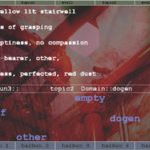first person
Deikto: A Language for Interactive Storytelling

Chris Crawford walks through Deikto, an interactive storytelling language that "reduce[s] artistic fundamentals to even smaller fundamentals, those of the computer: addition, subtraction, multiplication, and division."
GRIOT’s Tales of Haints and Seraphs: A Computational Narrative Generation System

D. Fox Harrell considers what is computational about composition, and describes the GRIOT system for generating literary texts.
On And Then There Were None

Lee Sheldon describes his playable adaptation of Agatha Christie's And Then There Were None, which relies on his invention of a "suspicion meter" to quantify and track the player's interaction with - and assessments of - NPCs (non-player characters).
Between Acting and Narrating: Editors’ Introduction to “Tabletop Systems”
The electronic release of Second Person starts with a number of essays on tabletop role-playing. Most of these consider the entanglement of play and narrative in a variety of game systems, from the highly controlled to the largely open-ended.
One Story, Many Media

Kevin Wilson describes his methodology of boiling a franchise down to its core elements and weighing the differences among media when translating games from medium to medium.